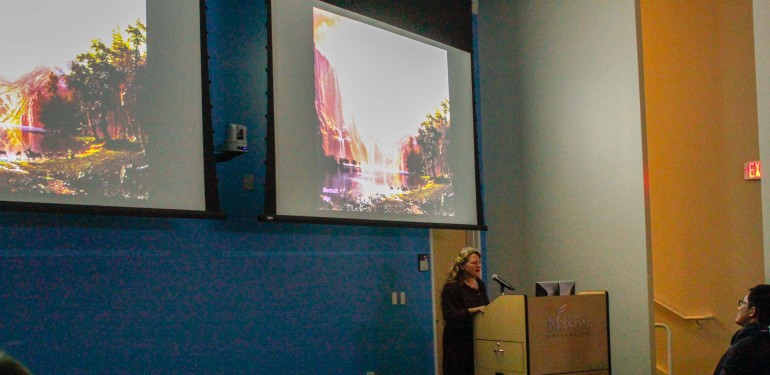Blanca Acevedo, staff writer
Art exhibitions can be used as a means of collaboration between the arts and sciences.
Dr. Changwoo Ahn, an Associate Professor in Environmental Science and Policy worked together with his co-chair associate Mark Cooley to realize this goal.
They wanted to provide perspective across the fields of ecosystem science and art and design by intertwining shared knowledge, expertise, and wisdom to creatively engage in the common pursuit of a sustainable future.
Ahn, creator and chair of “EcoScience + Art,” implemented the idea of an event that supports a joint effort among environmental sciences, the arts, and humanities. He intended to build an alliance within these studies and to find new transdisciplinary approaches for college general education, academic research, and collaborative endeavors with local organizations.
The EcoScience + Art, event that took place this week had guest speakers from different areas of expertise. However, they linked to ideas and the importance of protecting and enhancing the environment, while promoting health and well-being within our community.
Thomas Faha, director of Northern Reginal Office from the Virginia Department of Environmental Quality, started with an emphasis on storm water regulations. He discussed federal laws, policies and permissions, and explained the problems that DEQ have face during the past few years.
Faha also asked questions regarding air pollution, gasoline, electricity, natural gas, and water sources. He brought attention to these issues by asking “where [do] these come from?”
In general, he spoke in a very optimistic tone, inviting the audience to contribute to the future changes in the environment.
“No matter what major you are, we all have a role in protecting the environment,” Faha said.
Later on, Ahn introduced the Rain Project Student Leadership Group, a student participatory project aimed at developing innovative interdisciplinary education and scholarship.
“The purpose of this project is to raise awareness of storm water issues for the Mason community that are currently critical and carry out relevance towards our educational background” Ahn explained.
Stacy Levy, a sculptor, also spoke. She is interested in the natural world and was featured in the work of ecological artist, Jackie Brookner.
During her presentation “Rain is my client” she used the language of landscape and art as a vehicle to tell the ecological story of a place.Her projects seeks to create an understanding of the natural processes of the world, and convey to the audience an appreciation of the beauty of nature and of the atmosphere within urban surroundings.
Levy’s work is a mixture of creative concepts embracing the essence of nature with its climate changes. It is a fusion of sculpture, landscape design, architectural projects with engineering techniques.
“I work for climate and think of rain as my client,” Levy said. “If we see it as a storm problem, we are not embracing the cycle. We should embody changing conditions in our ecosystem.”
For example, some of her work such as “Calendar of Rain” implies beauty and utility, and art and engineering making solutions. It provides an evolving look at the weather.
“Rain is an extremely misunderstood conception. Art can register the action of nature, we can give ways to share our built surfaces. Is essential for us to make places where we can interact with nature as a whole,” Levy said. “If you bring and invest in nature you will get more, the benefits are countless. So set a natural process in motion with art and create a place to relate to rain. The self reflection that you get, it’s just marvelous!”
Ahn seeks projects like this to preserve and promote awareness for earth conservation.
“Why not design for inclement weather with new activities?” Levy asked. “Water is a life giving source, rain is not a wasteland of abiotic nothingess. We should yield in nature and not be so greedy.”
Photo credit: Amy Podraza




